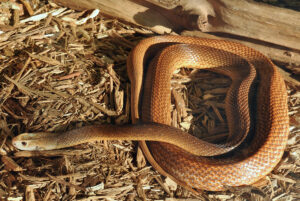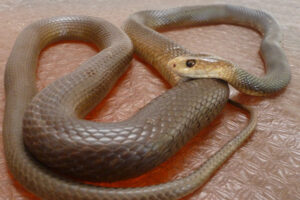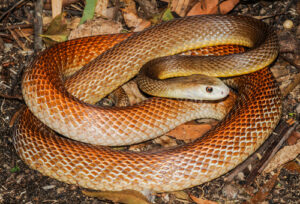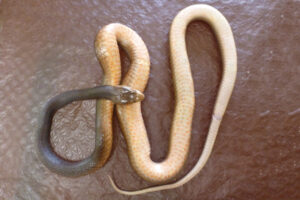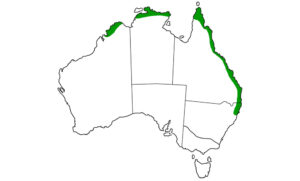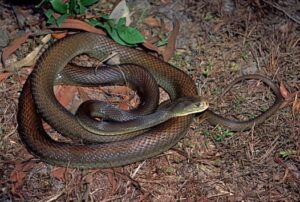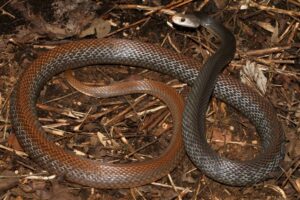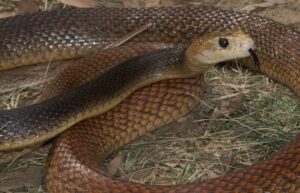The coastal taipan, commonly called the eastern taipan or the common taipan, is the world’s third most venomous snake after the inland taipan and eastern brown snake. It is Australia’s second-longest venomous snake after the king brown snake.
Their genus name ‘Oxyuranus’ originated from the Greek words oxys, meaning “sharp, or needle-like”, and Ouranos, meaning “heaven, or the vault of heaven”. And the species epithet “scutellatus” means “shaped like a small flat dish”, which refers to the flat and smooth scale of the species. The Wik-mungkan people of Cape York Peninsula, Australia, gave the ‘Taipan’ in their name.
These crepuscular species are primarily active during early spring and late winter but can be encountered throughout the year; however, they turn nocturnal during hot weather. Their local names include dirioro and gobari, given by the people of Parama village near the Fly River and the Vailala River.
Scientific Classifications
- SuborderSerpentes
- FamilyElapidae
- GenusOxyuranus
- SpeciesO. scutellatus
Conservation Status
Subspecies
This snake has two recognized subspecies:
- Coastal Taipan (O. scutellatus scutellatus)
- Papuan Taipan(O. scutellatus canni)
Description
Size
The average length of adult coastal taipans can reach up to 72-114 inches (6-9.5 ft.) and have a weight range of 6-14 lbs (3-6.5 kg). Male taipans tend to be slightly larger than females.
The largest specimen has been reported to grow over 9.5 ft. (2.9 m), with a snout-to-vent length of 7.3 ft (2.2 m).
Color and Appearance:
They have ridged scales and long, slender bodies. Their coloration ranges from almost black to dark brown, reddish brown, and yellow. The pale underparts of their bodies are cream-colored or yellow, covered with irregular orange spots. Among all Australian snakes, this species has the longest fangs, reaching half an inch (13 mm.)
The common taipans have long, narrow heads, almost shaped like a coffin, and their faces are light-colored. Their large, round eyes have an angular brow on top and are light brown or hazel. The snake’s eyes also have large pupils.
Coastal taipans have 21–23 dorsal scale rows at the midbody, 220–250 ventral scales with a single and undivided anal plate, 45–80 divided subcaudal scales, and 2+3 (3+4) temporal scales. The scale arrangement helps to differentiate this snake from the king brown snake with 17 dorsal scales and a divided anal plate.
Adult taipans go through a change seasonally. They become darker in color during winter, which absorbs sufficient heat to keep them warm. And in summer, their dark coloration fades, and the light color reflects the heat keeping them cool. Juveniles do not undergo this change.
Are they Dangerous
Coastal taipans might be the third most venomous snakes in the world, but their frequent encounters with humans make them more dangerous than inland taipans and eastern brown snakes. The maximum amount of venom that yields in one bite is 110mg, which means a single bite can kill more than 100 people.
Its danger level relies on factors like the injected amount, fang lengths, and the victim’s sensitivity to the toxins.
Their venom has an LD50 value of 0.1 mg/kg and contains many poisons, like neurotoxin that paralyzes the nerves of the diaphragm, heart, and lungs; myotoxin that disrupts the muscle tissues and a procoagulant that creates abnormal clotting, which leads to internal bleeding.
These snakes are very aggressive but tend to avoid close human contact. Most of the time, they aren’t about to attack; however, if provoked, they will strike very quickly and bite multiple times, injecting up to 60 mg of venom per bite.
Between 2005 and 2015, 31 cases of snakebite were attributed to coastal taipans. Two deaths were recorded between 1981 and 1991, and one more between 2000 and 2016. One such death was 77-year-old David Pitt, a local from Queensland. On 20th December 2016, he encountered a coastal taipan, tried to kill it with a shovel, and was bitten as a result.
Coastal Taipan At a Glance
Distribution
These snakes mainly inhabit the Australian coastline covering an extensive range. Their distribution spans the Cape York Peninsula, eastern Queensland, the northern part of New South Wales up to the city of Grafton, the Northern Territory, and the north-western part of Western Australia. There is also a population in the southern part of New Guinea.
In 1935, cane toads were released in the Australian wilderness, which might have led to an increase in the coastal taipan population then. Since these taipans only feed on mammals, they did not attempt to consume these poisonous toads and did not perish, unlike other snakes.
Habitat
They inhabit abandoned animal burrows, dead vegetation, tropical and temperate coastal regions, dry and wet sclerophyll forests and woodlands, hollow logs, natural and man-made grassy areas, as well as human habitats like sugarcane fields, grazing paddocks and abandoned landfills where their prey is abundant. Their most favored habitats are places with bushes of introduced sand verbenas.
These taipans live in areas with warm and wet temperatures and tend to avoid regions below 68 °F (20 °C) in winter.
Lifespan
There is little information about their longevity in the wild; however, their lifespan ranges between 10-15 years in captivity.
Predators
Their predators include goannas and large birds of prey. Juveniles and hatchlings are usually targeted, but predators also take the adults, even though it’s rare.
If threatened, common taipans arise in a position to strike by loosely raising themselves from head to neck, laterally compressing their bodies, and spreading the back of their jaws to make the heads broader and lance-shaped. Then they will accurately strike at the threat and inflict multiple bites. Since their bodies are muscular and lightweight, these taipans can move quickly and efficiently in all directions, sometimes even partially off the ground. These traits of the snakes allow them to defend themselves from larger threats.
Diet
All the taipans, including hatchlings, primarily feed on mammals and birds. Sometimes they also consume bandicoots, mosaic-tailed rats, other small native rodents, and marsupials like quolls.
They locate their prey using their sense of smell and via movement detection; with their tongues rapidly flicking in and out of their mouths, they sense the presence of their prey in the air.
After locating their prey, the taipans attack it quickly, inflicting venomous bites and instantly retreating to wait for the prey to die. This method is named “strike and release” hunting and is exclusively used by taipans. This way of attacking gives them advantages by paralyzing the prey and keeping the snake from getting hurt or injured. For example, a bandicoot possesses sharp claws and teeth and fights back aggressively when attacked.
Reproduction
These snakes are polyandrous, which means females mate with more than one male. The breeding season lasts from March through December. During courtship, males can be seen engaging in ritualistic fights, where they coil around each other in an attempt to force their opponent’s head down to the ground. These fights last for hours; the winning male will approach the receptive female.
The female lays a clutch of 3-21 whitish soft-shelled eggs in hollow logs, holes in the ground, or under tree roots. An average clutch consists of 11 eggs. Females in captivity often lay a second clutch. After laying eggs, they abandon their nests and do not participate in raising the newly hatched. The eggs hatch after 60-80 days of incubation; this period may vary depending on temperature. These hatchlings are 12-13 inches, growing rapidly under favorable conditions. Males reach their sexual maturity when they grow up to 2.62 ft, usually at 16 months, and females reach theirs at 28 months old when they are about 3.28 ft long.
Similar Species
The coastal taipan may sometime be confused with:
Eastern Brown Snake
Eastern brown snakes share some resemblance with coastal taipans. But, these taipans and eastern brown snakes can be distinguished by the distinctive cream color snout and rectangular head of the coastal taipan, which the eastern brown lacks. Also, eastern brown snakes have shorter fangs and a lower venom yield.
Northern Brown Snake
The northern brown snake is often confused with the coastal taipan due to the similarities in their head and neck structure, but they have darker snouts and faces.
Mulga Snake
The mulga snake co-occurs in similar habitats and is often mistaken as coastal taipan. But, they lack the coastal taipan’s cream-colored snouts and pale faces, like the eastern and northern brown snakes.
FAQs
Ans: While the coastal taipan is native to Australia, the black mamba inhabits sub-Saharan Africa. Also, their venom acts quicker than that of taipans. However, they both employ a similar “snap and release” strategy while hunting.
Ans: Despite possessing deadly venom, there is no record of inland taipans attacking humans due to their shy nature; on the other hand, the coastal taipan is quite aggressive and may attack if threatened.
Source
reptilegardens.com, snakecatchers.com.au, inaturalist.org, coolcompanions.com.au, media.australian.museum, alphotos.berkeley.edu, squarespace-cdn.com

